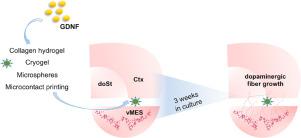Acta Biomaterialia ( IF 9.4 ) Pub Date : 2020-11-23 , DOI: 10.1016/j.actbio.2020.11.035 Buket Ucar 1 , Janko Kajtez 2 , Bettina M Foidl 1 , Dimitri Eigel 3 , Carsten Werner 3 , Katherine R Long 4 , Jenny Emnéus 2 , Joëlle Bizeau 5 , Mihai Lomora 5 , Abhay Pandit 5 , Ben Newland 6 , Christian Humpel 1

|
Protection or repair of the nigrostriatal pathway represents a principal disease-modifying therapeutic strategy for Parkinson's disease (PD). Glial cell line-derived neurotrophic factor (GDNF) holds great therapeutic potential for PD, but its efficacious delivery remains difficult. The aim of this study was to evaluate the potential of different biomaterials (hydrogels, microspheres, cryogels and microcontact printed surfaces) for reconstructing the nigrostriatal pathway in organotypic co-culture of ventral mesencephalon and dorsal striatum. The biomaterials (either alone or loaded with GDNF) were locally applied onto the brain co-slices and fiber growth between the co-slices was evaluated after three weeks in culture based on staining for tyrosine hydroxylase (TH). Collagen hydrogels loaded with GDNF slightly promoted the TH+ nerve fiber growth towards the dorsal striatum, while GDNF loaded microspheres embedded within the hydrogels did not provide an improvement. Cryogels alone or loaded with GDNF also enhanced TH+ fiber growth. Lines of GDNF immobilized onto the membrane inserts via microcontact printing also significantly improved TH+ fiber growth. In conclusion, this study shows that various biomaterials and tissue engineering techniques can be employed to regenerate the nigrostriatal pathway in organotypic brain slices. This comparison of techniques highlights the relative merits of different technologies that researchers can use/develop for neuronal regeneration strategies.
中文翻译:

基于生物材料的策略在器官切片共培养中重建黑质纹状体通路
保护或修复黑质纹状体通路是帕金森病 (PD) 的主要疾病缓解治疗策略。胶质细胞源性神经营养因子(GDNF)对帕金森病具有巨大的治疗潜力,但其有效递送仍然很困难。本研究的目的是评估不同生物材料(水凝胶、微球、冷冻凝胶和微接触印刷表面)在腹侧中脑和背侧纹状体器官型共培养中重建黑质纹状体通路的潜力。将生物材料(单独或加载 GDNF)局部施加到大脑复合切片上,并在培养三周后根据酪氨酸羟化酶(TH)染色评估复合切片之间的纤维生长。载有 GDNF 的胶原水凝胶略微促进了 TH+ 神经纤维向背侧纹状体的生长,而嵌入水凝胶内的载有 GDNF 的微球没有提供改善。单独的冷冻凝胶或负载 GDNF 的冷冻凝胶也能增强 TH+ 纤维的生长。通过微接触印刷固定在膜插入物上的 GDNF 线也显着改善了 TH+ 纤维的生长。总之,这项研究表明,可以采用各种生物材料和组织工程技术来再生器官型脑切片中的黑质纹状体通路。这种技术的比较突出了研究人员可以使用/开发的神经元再生策略的不同技术的相对优点。











































 京公网安备 11010802027423号
京公网安备 11010802027423号